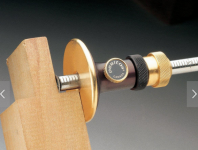In another thread, it came up that a marking knife gives more precise results than a sharpened #2 school pencil.
I have a marking knife. I can’t recall when it was last used.
I also have a Milwaukee “trim square” which is a carpenter’s’ square shrunk down to 4-1/2”. I find it very handy.
https://www.finehomebuilding.com/2023/03/15/space-saving-trim-square
“… I’m a huge fan of the highly visible contrasting etched markings, and the dual-reference heel is great for marking thin stock and reveals where trim elements meet. One side of the heel has a 1⁄4-in. lip and the other side has a 3⁄8-in. lip...”
I used the 3/8” lip to draw a line down the center of a 3/4” thick piece of poplar. Using a pencil and holding the pencil square to the surface the best that I am able, I made a line purporting to be the center of the stock.
I then flipped the square to the other side of the stock and made a second line parallel to the first. I ended up with a single line, just slightly wider than the original line.
I then repeated this exercise using the marking knife and holding the blade snug up against the lip of the square for both sides.
With the knife, I ended up with two distinct lines, exactly parallel to each other and about 1/32” apart. (It was difficult to measure, but clearly two lines.
So, is the knife more accurate? Not here. I am guessing that Milwaukee calibrated the legs to be used with a pencil.
See @ 2:00 minute mark.
I have a marking knife. I can’t recall when it was last used.
I also have a Milwaukee “trim square” which is a carpenter’s’ square shrunk down to 4-1/2”. I find it very handy.
https://www.finehomebuilding.com/2023/03/15/space-saving-trim-square
“… I’m a huge fan of the highly visible contrasting etched markings, and the dual-reference heel is great for marking thin stock and reveals where trim elements meet. One side of the heel has a 1⁄4-in. lip and the other side has a 3⁄8-in. lip...”
I used the 3/8” lip to draw a line down the center of a 3/4” thick piece of poplar. Using a pencil and holding the pencil square to the surface the best that I am able, I made a line purporting to be the center of the stock.
I then flipped the square to the other side of the stock and made a second line parallel to the first. I ended up with a single line, just slightly wider than the original line.
I then repeated this exercise using the marking knife and holding the blade snug up against the lip of the square for both sides.
With the knife, I ended up with two distinct lines, exactly parallel to each other and about 1/32” apart. (It was difficult to measure, but clearly two lines.
So, is the knife more accurate? Not here. I am guessing that Milwaukee calibrated the legs to be used with a pencil.
See @ 2:00 minute mark.


